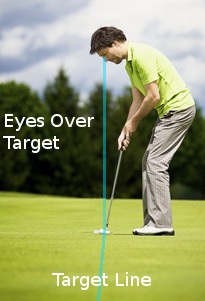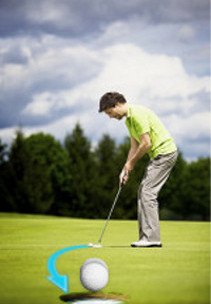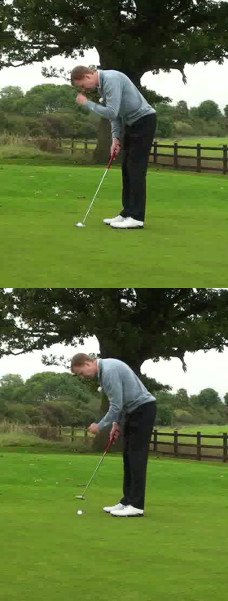You can improve your putting through proper use of your eyes during each stage of the process. Here's how:

Setup
- At address, the eyes should be directly over the golf ball and target line, or just inside it.
- To help position your eyes over the ball, most putter heads have a top surface split into two separate elevations, with an indicator placed on each elevation. When used correctly, this mechanism ensures your eyes are directly over the ball. If your head/eyes drift outside or inside the ball, the putter's bi-level alignment indicators will no longer match up.
The stroke
- Keep your eyes on the ball and over the target line throughout the stroke.
After contact
- After contact, focus on the grass that was under the ball. You're not going to improve the putt by watching it roll, so don't be in a rush to look up.
- Once the ball is long gone, swivel your head down the target line rather than lifting it. Rising up prematurely will change your spine angle and move your head off the target line.
Thomas Golf Putters
Traditional, Mid-Length/Belly & Long Putters
With a rare exception from time to time, each hole you play is going to end with the use of your putter.

The putter is the most-often used club in the bag, and it isn't even close. Even a good putting day is going to see you use your putter somewhere around 25 – 28 times, and none of your other clubs will get anywhere near that total. So, it should go without saying that you need to be adept at putting if you are going to reach your goals in this game. Without a reliable putter on your side, it is simply impossible to shoot low scores.
In this article, we are going to talk about how you can use your eyes to improve your putting performance. You may not have thought much about it previously, but you can actually use your eyes to improve your putting in a number of ways. Specifically, we are going to highlight three different ways you can use your eyes effectively on the greens. Once you have read through the advice we have to offer, you should have plenty to work on during your next trip to the practice green.
Although this article is focused specifically on how to use your eyes while putting, there are many other important fundamentals which should not be forgotten. For instance, you need to keep your hands quiet during the stroke while using your shoulders to rock the putter back and through. Also, you will want to maintain a light grip pressure on the handle of the club from start to finish. Only when you have all of your putting fundamentals in order from top to bottom can you really expect to see great outcomes.
All of the content below is based on a right-handed golfer. If you happen to play left-handed, please take a moment to reverse the directions as necessary.
Reading the Greens

Before you even take your stance to hit a putt, your eyes are going to play a big role in your success. As you already know, you need to read each of your putts and that job is going to fall mostly to your eyes. Getting a good look at the green will help you not only pick the right line for the putt, but it will also help you judge the pace you are going to use.
Reading greens is a complex subject, and we aren't going to be able to cover everything you need to know in this one section. However, we have assembled some basic green-reading tips which should help you achieve improved results sooner rather than later.
- Play more break. Most of the time, amateur golfers fail to play enough break for the slope at hand. It is common for amateur golfers to under-read their putts, leaving the ball on the low side of the hole by the time it gets up near the cup. In fact, some golfers refer to the low side as the 'amateur side' since this pattern is so typical. The only thing you need to do in order to break this habit is to play more break. If you notice that most of your putts wind up diving down under the low side of the cup, make it a point to aim on a higher line during an upcoming practice session. This will feel uncomfortable at first since you are used to playing less break. Stick with it, however, and you will see your results start to improve. Once you see how successful you can be by playing the ball on a higher line, this style of putting will quickly become comfortable.
- Read the end of the putt. In terms of the side-to-side break, the end of each putt is going to be more important than the beginning. This is for a very simple reason – the ball will be moving slower near the end of the putt, which will cause it to be more significantly impacted by the slope of the ground. So, if the ground is sloped left to right at the start of your putt and right to left at the end, it is that right to left portion around the hole that should get most of your attention. Sure, you will still need to consider the beginning of the putt as well, but that portion is not going to play as much of a role in your final read.
- Don't assume on short putts. Some golfers get into the habit of thinking they don't need to worry much about break on short putts. When inside of a few feet, these players will just aim for the middle of the cup and make a stroke. That isn't going to get the job done. Sure, you'll make one from time to time when the ground happens to be flat, but you can never assume in this game. Even on short putts, you should still take a moment to read the slope of the ground before you proceed. Missing short putts is one of the quickest ways to ruin your score, so be disciplined and get an accurate read no matter the length of putt you are facing.
- Check from both sides. Part of the problem you may be having with reading the greens could come down to nothing more than laziness. In order to get an accurate read on a putt longer than a few feet, you really need to view the putt from both ends. In other words, you need to read the putt from behind the ball, and you need to read it from behind the hole, as well. Unfortunately, many golfers skip the step of reading their putts from behind the hole. Instead, they just take a look from behind the ball, take a practice stroke or two, and go for it. The problem here has to do with the point we made earlier about the ball breaking more at the end of its roll than the beginning. Since the ball is going to take more break at the end, you really do need to get down behind the hole to get a good view of the slope. With that image in your mind it will become much easier to pick out the right target line.
There is no substitute for experience when it comes to green reading. Sure, tips like those listed above will help, but they will only take you so far. At some point, it is just going to come down to learning through trial and error. The best way to gain this experience is not to get out onto the course, but rather to read more putts in practice. While practicing your putting, don't just roll one ball after the next without giving it a second thought. Take a moment to read each putt, pick out a target line, and then make your stroke. This takes longer, and you won't wind up hitting as many putts in a given practice session, but those you do hit will be far more useful. If you can get into this kind of habit during practice, it is highly likely that your on-course results will begin to quickly improve.
Finding the Right Position

In this section, we aren't going to talk so much about where you are looking with your eyes, but rather where they are positioned in relationship to the ball at address. This is an easy point to overlook, but it is very important if you are to produce a great stroke time after time. By placing your eyes in the right spot, your head will obviously be in the right spot as well – and you'll be a big step closer to a quality putting stroke that you can trust to send the ball in the proper direction.
So, where should your eyes be located while you are putting? For most players, the right spot is just inside of the target line, and slightly to the right of the ball (as viewed from address). In other words, when you take your stance and look directly down at the ground, you should be looking at a spot which is a little closer to your feet than the ball, and a little to the right. This is going to be an excellent position from which to putt – at least, for most golfers.
Commonly, you will hear golf instructors say that you should place your eyes directly over the ball, and that can work in some cases. However, we feel that most golfers will benefit from keeping their eyes just inside the line, and just to the right of the ball. This type of positioning promotes an arc-shaped putting stroke, which is the most natural way to roll the ball toward the hole. Also, by setting your head just to the right of the ball, you should be able to hit up slightly at impact. That is desirable as well, since it will help you to get the ball rolling cleanly as soon as possible.
Now that you know where your eyes should be, the only thing left is to figure out how to get them into the right spot. Fortunately, that is pretty easy. To handle the task, all you will need is your putter and a couple of golf balls. First, put one ball in your pocket and place the other on the ground at your feet. Take your stance and position your body where you think you should be standing. Once you are happy with your address position, let go of the putter with one hand and retrieve the extra ball from your pocket. Then, hold that ball up to the bridge of your nose and drop it. The ball will drop straight down and will show you exactly where your eyes are positioned. If the ball drops inside and to the right of the ball that was already on the ground, you are good to go. If not, make the necessary adjustments and try again. This quick drill is always a good one to use when you need to check on your eye positioning.
In addition to placing your eyes in the right spot, you will also want to make sure the rest of your stance is in proper working order. Your knees should be slightly flexed, your back should be straight, and your chin should be up away from your chest. In addition, you should be tilted forward from the hips, so your arms can hang straight down from your shoulders. With all of that sorted out, rolling a great putt will suddenly be easier than ever before.






